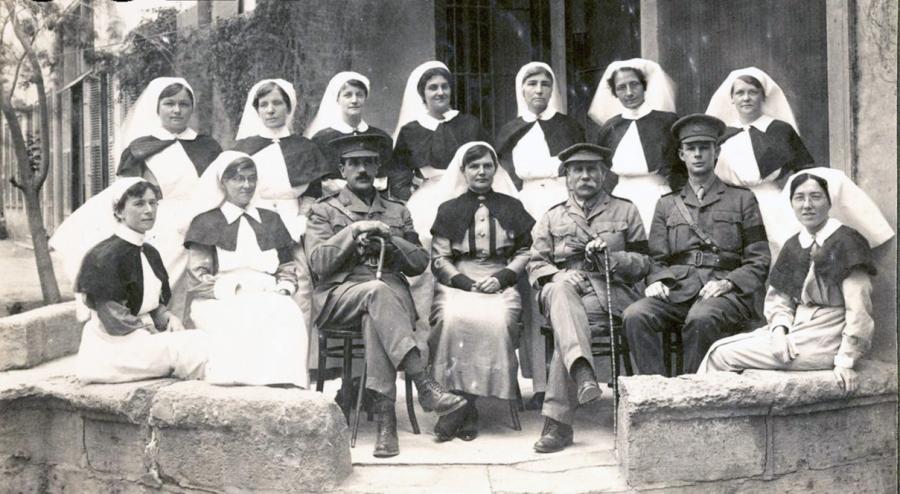“Their last hope had gone”
A group of Australian nurses and a patient at the No. 3 Australian General Hospital in Egypt, 1916. Florence Elizabeth James-Wallace is on the left.
On 12 May each year, we celebrate International Nurses Day. For more than 100 years, nurses have played a critical role in Australia’s military history. More than 3,000 Australian nurses enlisted for service during the First World War. Nursing provided Australian women with opportunities for independence, travel, and to learn new skills. As well as caring for Australian troops, they nursed civilians and enemy prisoners. From the snow in France to the intense heat of India, nurses faced long hours and difficult working conditions.
Members of the Australian Army Nursing Service, pictured on camels in front of the Sphinx and pyramids
The “Nurses Narratives” are a collection of 142 first-hand accounts of the experiences of nurses during the First World War. They detail the personal experiences of nurses in their own words, as collected and used by historian Arthur Butler to write the official history of the Australian Army Medical Services.
A particularly good example is presented by Sister Florence Elizabeth James-Wallace, who enlisted the day after the Gallipoli Landing on 26 April 1915. She served in England, Lemnos and Egypt before finding herself very close to the front line of the German Spring Offensive in March 1918. Florence’s narrative, given in diary form, recounts a remarkable week of service in France.

Queenslanders at the No. 3 Australian General Hospital in Egypt, 1916. Florence is at the far left of the front row. Photo credit: The University of Queensland
21 March 1918
Florence worked on night duty with two other sisters at the 61st Casualty Clearing Station in Ham, France. She writes of hearing planes overhead, “at about 4.15 am a terrific bombardment commenced, like continuous thunder rolling”. Florence noted that she “felt quite excited” by the event. After going to bed at 10 am and waking at 4 pm, Florence found the hospital “buzzing with excitement and patients everywhere”. The wards were overflowing and Florence worked throughout the night providing medical assistance to the patients.
22 March 1918
After a long night on duty, Florence slept through the morning. She recounts being awakened by Matron Baird at 2 pm, “Girls! Get up quickly, you have to be dressed in 10 minutes, the train goes in 20. We have to leave everything”. The Germans had advanced and the clearing station had to be evacuated. Florence and the other nurses grabbed all they could and headed to the train station. Florence remembered “feeling very disgusted at being sent off when we feel the patients need us”.
“Crash! A shell bursts about 200 yards away … then another crash a little nearer”, Florence recalled. The soldiers and nurses picked up their belongings and ran to the other side of the train line. German planes continued to drop bombs overhead and some nurses dived for the dugouts. Others, including Florence, chose to “sit on our luggage and watch”.
Florence boarded one of five lorries that had been arranged to take the nurses to Rosieres, France. They arrived at 47 Casualty Clearing Station in Rosieres at 10 pm and were welcomed with tea, bread, and butter.
23 March 1918
The next morning, Florence and her friend explored nearby French and German trenches, overgrown and covered in “rusty wire entanglements”. Upon returning to the clearing station, Florence received the order by Matron Baird to be “ready in 20 minutes to go”. Florence and six others were taken by ambulance to Villers-Bretonneux. Arriving at the entraining centre, Florence provided medical attention to wounded soldiers returning from the Somme, many of whom were transported out in the evening by train. After a full day’s work, Florence and the nurses walked to the local school where they were billeted alongside refugees.
24 March 1918
Florence arrived at the centre to find 500 patients awaiting treatment. She worked throughout the day providing medical attention and feeding the patients bully beef, biscuits, and tea.
25 March 1918
Florence arrived to find 8,000 patients at the centre. She wrote, “the space on either side of the hut and facing the line was covered with stretcher cases for hundreds of yards”. Florence spent the day triaging, feeding and dressing the wounds of patients, around 10,000 of whom passed through the centre that day.
Around 11 pm, Florence began walking back to the school. As she reached the town, German aircraft started dropping bombs. Florence recalled “one seemed to fall beside us with a deafening splitting sound. We dived into an archway … 2 other sisters behind us fell flat on the pavement. However none of us were hit and we got to the school”.
26 March 1918
Florence returned to the centre and found patients from the previous day still awaiting medical attention. “They were very thirsty, dirty and some covered with blood”. At 12.30 pm, the order was given to return to the school and pack. Florence packed her belongings, had a quick lunch and returned to the centre. After hearing the train was coming, Florence began running down the hill through the line of patients. “I will never forget the expression on their [the patients] faces when they saw we were going. ‘Oh they are leaving us’, ‘they are going’. I heard one man say. I went back to tell him we were going on a truck train and they would be going as soon as the hospital train arrived. It didn’t seem to comfort him much. They looked as if they thought their last hope had gone, poor things, we hated leaving them, and it made us realize our being there meant more than the actual work we did.” Florence climbed into the train alongside the wounded. The nurses piled their kit bags together and tried to get some sleep.
Florence recalled, “about 10 pm we heard Fritz, and after that we had a terrible night of bombing … a dud dropped beside us, the line blown up in front of us”. She wrote, “it certainly was the most nerve racking thing we had been through”.
27 March 1918
Florence’s train arrived in Amiens around 11 am. Here she witnessed the devastation of the bombings from the previous night and saw “telegraph wires smashed … and broken glass everywhere”. The nurses arrived in Vauvillers around 2 pm and Florence began night duty in the dressing tent. She was billeted with a French woman and slept “in a lovely soft French bed”.
28 March 1918
Florence spent a busy day working in the dressing tent. After finishing around 10 pm and getting two hours of sleep, she was awakened at midnight to evacuate. She travelled via ambulance to pick up the other nurses and hurried to the train station. They had missed the train but were told another was to arrive any minute. Florence waited all night in the rain and didn’t catch a train out until 9 am the next morning and “so ended a week in France” for Florence.
Florence returned to Australia in 1919 and later moved to New Zealand to take up the position of matron at Auckland Hospital. She married Harry Oswald Mellsop in 1927 and passed away in Auckland in 1971.
Sister Florence Elizabeth James-Wallace’s narrative is one of 142 accounts that form the “Nurses Narratives” sub-series in the Official Records Collection AWM41, the records of Arthur G. Butler. Each story is held as an individual file numbered between 937 and 1078. All have now been digitised and are available online as part of the Memorial’s Digitisation Project.
Sister Florence’s extraordinary narrative is available to read in full here: AWM41 985.





